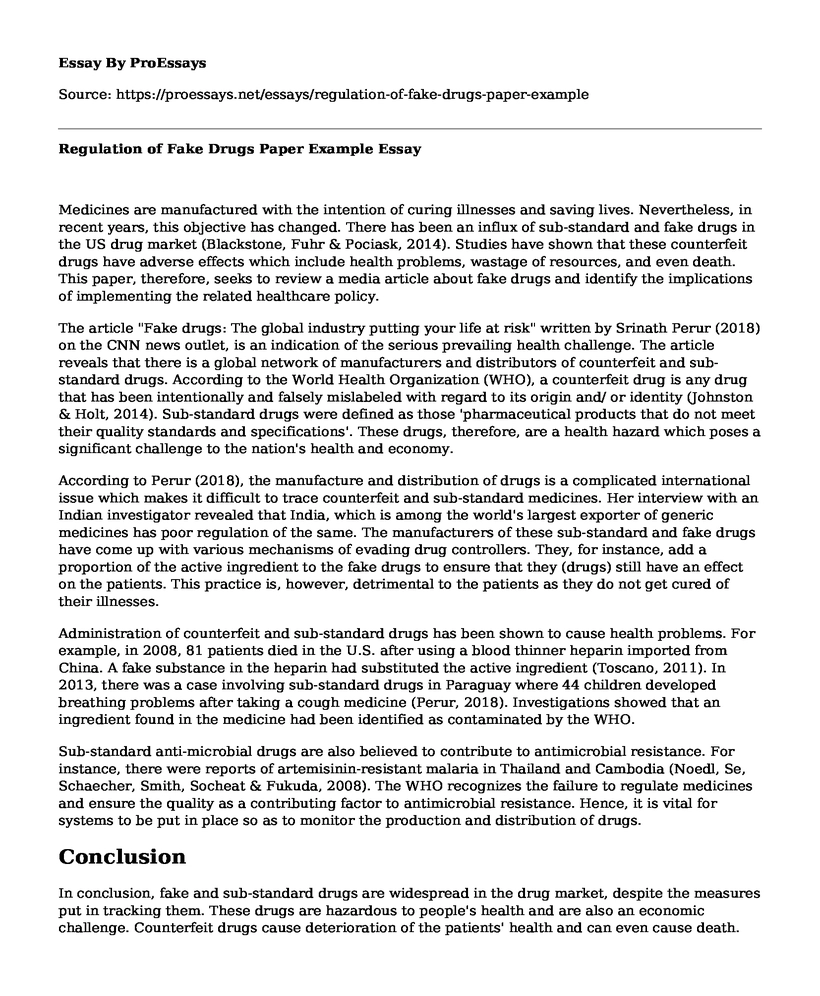Medicines are manufactured with the intention of curing illnesses and saving lives. Nevertheless, in recent years, this objective has changed. There has been an influx of sub-standard and fake drugs in the US drug market (Blackstone, Fuhr & Pociask, 2014). Studies have shown that these counterfeit drugs have adverse effects which include health problems, wastage of resources, and even death. This paper, therefore, seeks to review a media article about fake drugs and identify the implications of implementing the related healthcare policy.
The article "Fake drugs: The global industry putting your life at risk" written by Srinath Perur (2018) on the CNN news outlet, is an indication of the serious prevailing health challenge. The article reveals that there is a global network of manufacturers and distributors of counterfeit and sub-standard drugs. According to the World Health Organization (WHO), a counterfeit drug is any drug that has been intentionally and falsely mislabeled with regard to its origin and/ or identity (Johnston & Holt, 2014). Sub-standard drugs were defined as those 'pharmaceutical products that do not meet their quality standards and specifications'. These drugs, therefore, are a health hazard which poses a significant challenge to the nation's health and economy.
According to Perur (2018), the manufacture and distribution of drugs is a complicated international issue which makes it difficult to trace counterfeit and sub-standard medicines. Her interview with an Indian investigator revealed that India, which is among the world's largest exporter of generic medicines has poor regulation of the same. The manufacturers of these sub-standard and fake drugs have come up with various mechanisms of evading drug controllers. They, for instance, add a proportion of the active ingredient to the fake drugs to ensure that they (drugs) still have an effect on the patients. This practice is, however, detrimental to the patients as they do not get cured of their illnesses.
Administration of counterfeit and sub-standard drugs has been shown to cause health problems. For example, in 2008, 81 patients died in the U.S. after using a blood thinner heparin imported from China. A fake substance in the heparin had substituted the active ingredient (Toscano, 2011). In 2013, there was a case involving sub-standard drugs in Paraguay where 44 children developed breathing problems after taking a cough medicine (Perur, 2018). Investigations showed that an ingredient found in the medicine had been identified as contaminated by the WHO.
Sub-standard anti-microbial drugs are also believed to contribute to antimicrobial resistance. For instance, there were reports of artemisinin-resistant malaria in Thailand and Cambodia (Noedl, Se, Schaecher, Smith, Socheat & Fukuda, 2008). The WHO recognizes the failure to regulate medicines and ensure the quality as a contributing factor to antimicrobial resistance. Hence, it is vital for systems to be put in place so as to monitor the production and distribution of drugs.
Conclusion
In conclusion, fake and sub-standard drugs are widespread in the drug market, despite the measures put in tracking them. These drugs are hazardous to people's health and are also an economic challenge. Counterfeit drugs cause deterioration of the patients' health and can even cause death. Sub-standard drugs, on the other hand, have contributed to antimicrobial resistance. I strongly believe that new ways should be invented to ensure that imported drugs are thoroughly screened before they are distributed. Also, strict sentences should be made on those found engaging in this illegal trade.
References
Blackstone, E. A., Fuhr Jr, J. P., & Pociask, S. (2014). The health and economic effects of counterfeit drugs. American health & drug benefits, 7(4), 216.
Johnston, A., & Holt, D. W. (2014). Substandard drugs: a potential crisis for public health. British journal of clinical pharmacology, 78(2), 218-243.
Noedl, H., Se, Y., Schaecher, K., Smith, B. L., Socheat, D., & Fukuda, M. M. (2008). Evidence of artemisinin-resistant malaria in western Cambodia. New England Journal of Medicine, 359(24), 2619-2620.
Perur, S. (2018). Fake drugs: The global industry putting your life at risk.https://edition.cnn.com/2018/10/30/health/fake-medicine-partner/index.htmlToscano, P. (2011). The dangerous world of counterfeit prescription drugs. www.cnbc.com/id/44759526
Cite this page
Regulation of Fake Drugs Paper Example. (2022, Sep 26). Retrieved from https://proessays.net/essays/regulation-of-fake-drugs-paper-example
If you are the original author of this essay and no longer wish to have it published on the ProEssays website, please click below to request its removal:
- Paper Example on Continuous Quality Improvement (CQI)
- Comparison of Clinton and Obama Health Care Systems Essay
- Supplements for Strength-Power Athletes Paper Example
- Brown Vs. Board of Education Essay Example
- Exploration of a Shared Information System in Baylor Scott and White Health - Essay Sample
- Essay on Interprofessional Collaboration: Improving Care Quality and Reducing Hospital Costs
- Paper Example on PMHNP Practicum: Integrating Theory with Professional Practice







